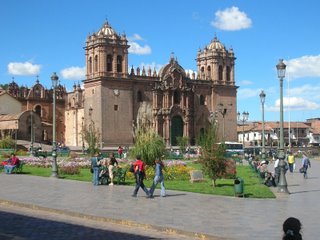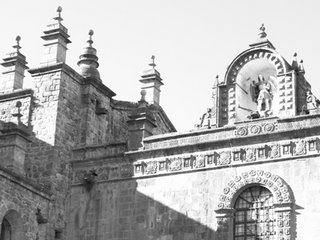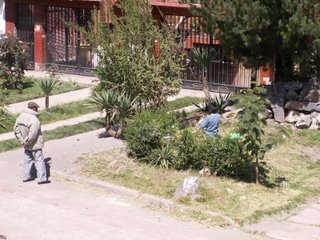CUSCO – We made it. StarPeru held the flight in Arequipa for about an hour while the weather cleared. We finally made it at around 9:30. We were met with more hugs and kisses from Miguel Miranda Acuña, Sonia’s brother in law. Miguel speaks no English, and we speak no Spanish, but we got along anyway. He took us to his lovely home just outside the city center, where his Señora, Evita, had prepared for us coca tea and thick mango juice.
After breakfast, we went upstairs to our room to freshen up and shower. While Cathy was showering, I was gazing out the window at a house across the street. A boy was outside, burning something in a large barrel. I couldn’t figure out what he was doing.
Residential construction in Peru is quite terrible. I think it boils down to a scarcity of good but affordable materials. Our room upstairs has no insulation, single-paned glass, and corrugated steel for a roof. That said, the bed was extremely comfortable and the blankets were very ample. We will no doubt be plenty warm tonight.
The shower head was another story. There is no hot water plumbed into the house, so the water is heated by an element in the showerhead, powered by an exposed wire coming from the wall. It’s OK though – as long as you don’t touch the metal part of the faucet head, you won’t get electrocuted. Cathy stayed last night with Sonia’s father Alejandro and she tells me that his showerhead is even scarier.
 Shower heads of the damned! This is Alejandro's shower head. You had to flip the breaker to turn it on after turning on the tap. Whatever you do, don't fiddle with the tap once the electricity was on. Residential showers in Peru were an exercise of courage and character.
Shower heads of the damned! This is Alejandro's shower head. You had to flip the breaker to turn it on after turning on the tap. Whatever you do, don't fiddle with the tap once the electricity was on. Residential showers in Peru were an exercise of courage and character.After we showered and changed (the air is very brisk at this altitude – nearly 11,000 feet elevation), Miguel took us into town to visit Deishy who runs a pre-school, and to set us up with a tour. (As I am writing, a man outside my window is walking down the street selling produce. He’s shouting “papayas!” through his bullhorn).
 Deishy at the Jardin.
Deishy at the Jardin.
 The kids were practicing their dance steps for a Mother's Day Pageant they were to throw at the end of the week.
The kids were practicing their dance steps for a Mother's Day Pageant they were to throw at the end of the week.Miguel set us up for lunch at the Restorante Don Antonio, which served a beautiful buffet. With wine, the meal totaled $15 per person. They like their meat well done here. I had a wonderful dessert called a tomate de arbor, which was very sweet and tart. We shopped and strolled around the Plaza de Armas. There is shop after shop in Cusco selling anything from schlock to exquisite merchandise. There is also no shortage of itinerant street vendors, including women dressed in the native costume, their child in hand and a baby llama on their backs. They can be insistent. I was given a guilt trip in perfect English by a child who wanted to shine my shoes.
 Cusco City Hall. In this region of Peru, they favor the Inca standard over the Peruvian national flag. Cathy and I referred to the banner as the Inca Pride Flag.
Cusco City Hall. In this region of Peru, they favor the Inca standard over the Peruvian national flag. Cathy and I referred to the banner as the Inca Pride Flag.Cathy and I visited two churches, the Compania and the Catedral, both on the plaza. In truth, the Catedral complex consists of two churches on either side of the main church. The churches were enormous and the art was magnificent, rivaling anything I have seen in Europe. If anything, these churches seem better tended. The sacredness of the space is jealously guarded and photography is not allowed.
Stunningly, the baldacchino in the Cathedral was plated in silver. The art and architecture beautifully merged Spanish colonial motifs with Inca forms. For example, a painting of the Last Supper in the Catedral shows Christ and the Apostles eating guinea pig and drinking beer from Incan mugs. They did not paint on the walls or on plaster, as they do in some European Churches. Here, they painted on huge canvases built to fit the walls of the church.
 The Catedral is a beautiful, imposing, Spanish Church. It is flanked by churches on either side. Photography was not permitted inside the churches in Cusco but - take my word for it - they were spectacular.
The Catedral is a beautiful, imposing, Spanish Church. It is flanked by churches on either side. Photography was not permitted inside the churches in Cusco but - take my word for it - they were spectacular.We had a wonderful guide in the Catedral who loved to talk about The Da Vinci Code. He speculated that the effeminate man seated next to Jesus in the Last Supper painting was actually Mary Magdalene.
After our visit to the churches, Cathy and I enjoyed a cup of coffee and a dulce de leche pastry at a charming old café on the Plaza next to the Catedral.
 At the cafe. It was so yummy we went twice. While their pastries were exquisite, the coffee here and elsewhere in Peru was not the best, which is surprising given that coffee is one of Peru's leading export commodities. We then learned that all the good coffee is sold abroad. A few days into the trip, we learned to skip the coffee, instead drinking their delicious coca tea.
At the cafe. It was so yummy we went twice. While their pastries were exquisite, the coffee here and elsewhere in Peru was not the best, which is surprising given that coffee is one of Peru's leading export commodities. We then learned that all the good coffee is sold abroad. A few days into the trip, we learned to skip the coffee, instead drinking their delicious coca tea. Detail of the Triunfo Church, which shares a wall with the Catedral. Note the life-size statue of the saint in the sconce above the window.
Detail of the Triunfo Church, which shares a wall with the Catedral. Note the life-size statue of the saint in the sconce above the window. The Compania is in my opinion the most beautiful church in Cusco, and one of the most beautiful in the world.
The Compania is in my opinion the most beautiful church in Cusco, and one of the most beautiful in the world.






No comments:
Post a Comment